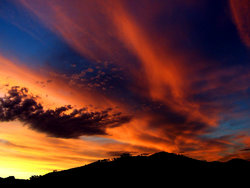Sky
|
|
For other uses, see Sky (disambiguation).
SI-Sky.JPG
Turbulent_skies.jpg
Stormy_skies.jpg
Trees-sky.jpg
The sky is often defined as the place a person sees when he or she looks up from the earth. Although almost everyone has seen it, the sky is hard to define precisely. The concept of the sky, as it is applied here on Earth, can be generalized to mean the hemisphere above the horizon, or above the visible surface of the planet and objects attached to it. It can be seen when one looks upward from the surface of a planet (see Skies of other planets). The sky is also sometimes defined as the denser gaseous zone of a planet's atmosphere. Birds, airplanes, and kites are often considered to fly in the sky.
The color of the sky is a result of diffuse sky radiation. On a sunny day the Earth sky usually looks as a blue gradient - dark in the zenith, light near the horizon (due to Rayleigh scattering). It turns orange and red during sunrise and sunset, and becomes black at night. During the day the Sun can be seen in the sky, unless covered by clouds. In the night sky (and to some extent during the day) the Moon, planets and stars are visible in the sky. Some of the natural phenomena seen in the sky are clouds, rainbows, and aurorae. Lightning can also be seen in the sky during storms. As a result of human activities, smog during the day and light radiance during the night are often seen above large cities (see also light pollution).
In the field of astronomy, the sky is also called the celestial sphere. This is an imaginary dome where the sun, stars, planets, and the moon are seen to be travelling in. The celestial sphere is divided into regions called constellations.
See skies of other planets for descriptions of the skies of various planets and moons in the solar system.
Sky in religion
Many cultures ascribed strong religious qualities to Earth's sky, believing it to be the home of the heavens and various deities. Among the Chinese, in certain situations, sky means god. For example, people may say "They became friends after several fights: this is the idea of the sky" or "Why does the sky always fool me?" Some religion and art historians believe that in Christianity, in particular, the connection between heaven and sky arose because of a medieval painting technique, where different places were drawn separately on the same picture. Heaven, a different and more important world, was usually painted above the earthly world and was separated from it by clouds.
Deities of the sky
- Ouranos/Uranus, Zeus/Jupiter (Greek/Roman mythology)
- Shu, Nuit, Horus (Egyptian mythology)
- Cabaguil (Maya mythology)
- Torngasoak (Inuit mythology)
- Anu (Goidelic mythology)
- Ashanti (Ashanti mythology)
- Denka (Dinka mythology)
- Altjira, Baiame (Aboriginal mythology)
- Sin (Haida mythology)
- Shanga (Yoruba mythology)
- Gamab (Khoikhoi mythology)
Expressions
- A pie in the sky is something that is wanted very badly but is unobtainable.
- When someone's assumptions and premises about everything spoken about seem to radically different from everything you know and recognize about the world, you wonder what color the sky is in their world.
- Similarly, because the blue hue of the sky during daytime is such a universally observed and understood phenomenon, people say "as sure as the sky is blue" to mean that something is an indisputable fact.
- Blue skies are evoked as a symbol for good times, optimism and emotional peace.
- To be sky-clad means to be in the nude.
- Similarly, to go skying is a euphemism for stripping or streaking.
- To show that there are no limits on what we can discover or accomplish, you can say, "The sky's the limit!"
- "Blue sky thinking" means coming up with a host of ideas without being restricted to what is practical (similar to brainstorming); in particular, an optimistic assumption is made that there will be no obstacles or opposition to implementation of the ideas.da:Himmel
de:Himmel (planetär) es:Cielo fr:Ciel he:ש××× hi:आसमान ko:하늘 pt:Céu simple:Sky

